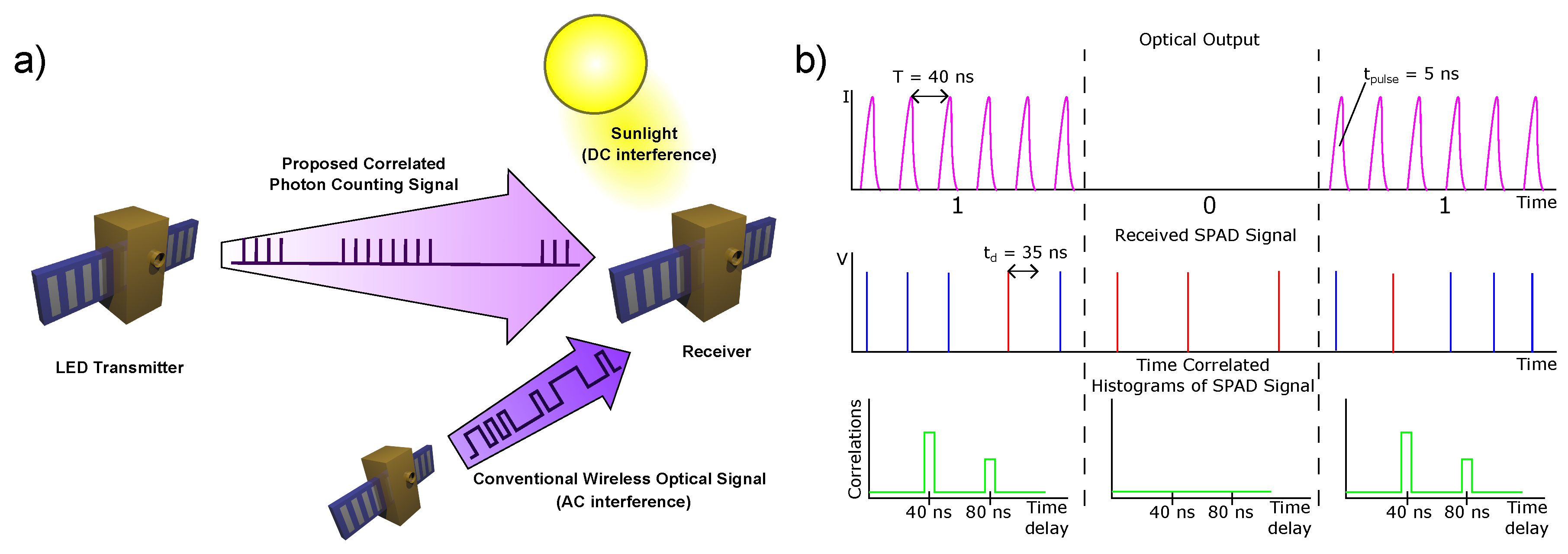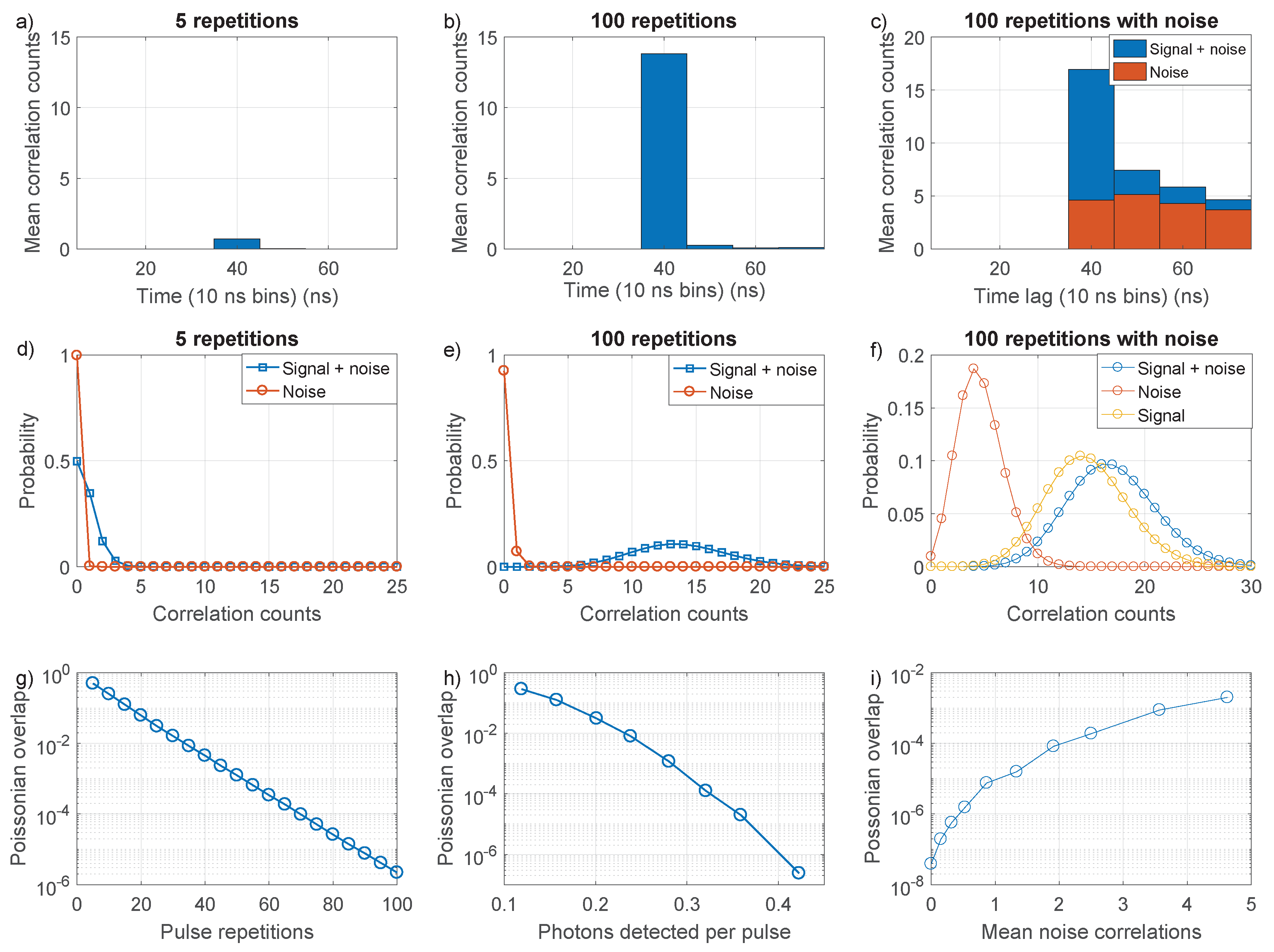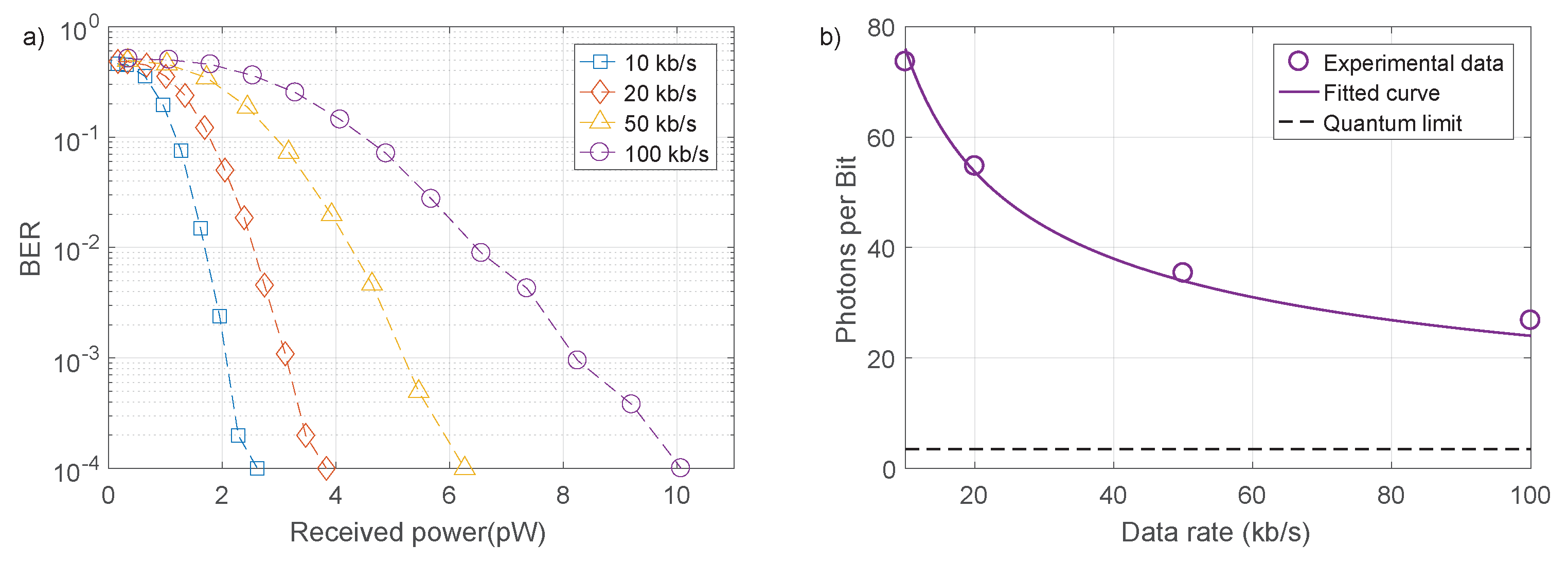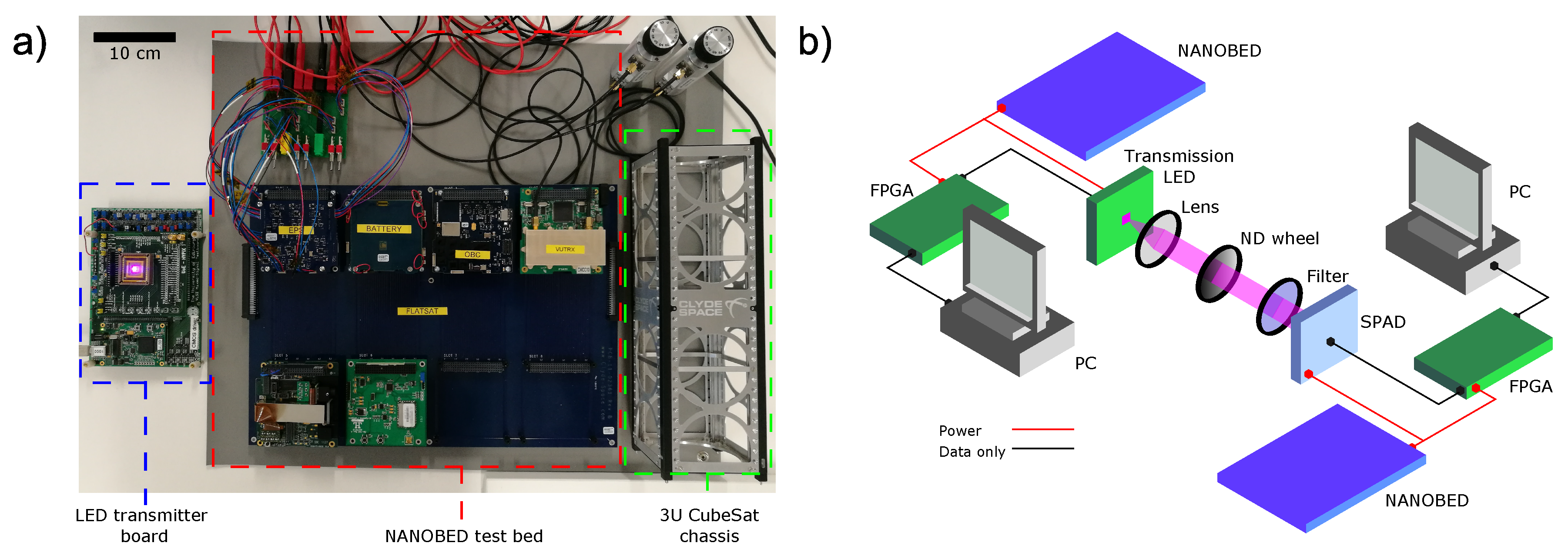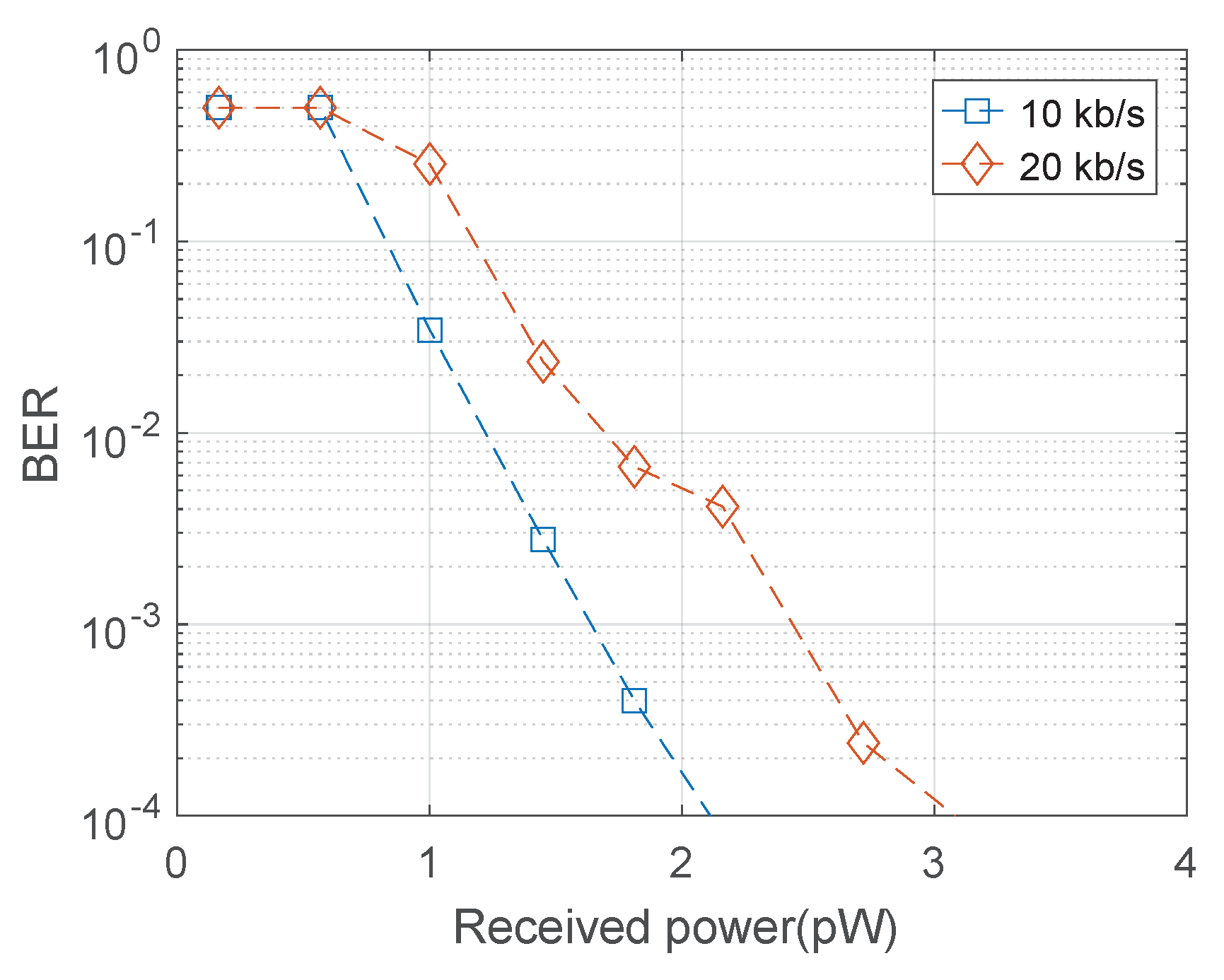2.1. Time Correlation Encoding Scheme
The transmission scheme presented here, inspired by time-correlated single photon counting (TCSPC) techniques often used for fluorescence lifetime imaging [
20], involves the use of a single SPAD to receive time correlated signals at a single photon level. Analysis of the SPAD response to incoming light over an interval
shows that the correlation count density function
of recording two subsequent SPAD counts with temporal separation in the interval
is given by:
Here,
is the temporal probability distribution of received SPAD pulses, which is determined by the optical signal from the transmitter. Full analysis is given in the Supplementary Materials of Reference [
21]. If a suitable optical source transmits pulses with a time separation of
T,
will show a peak at
, as the probability of observing SPAD pulses separated by
T is increased. Equation (
1) is the autocorrelation of
, so it is expected that peaks in
would have a width of
, where
is the width of the optical pulse. After detection of a photon, the output of a SPAD has a “dead time” (
) in which it is insensitive to further photons, typically 10 s of ns in length [
6,
12]. It is important that
, as otherwise the SPAD would not recover from the first pulse in time to see the second. This restriction can be lifted by using a SPAD array [
22,
23], however here we consider the use of only a single SPAD. The presence and/or temporal position of peaks in
directly depends on the sequence of optical pulses from the transmitter, and therefore can be used as a means of transmitting data.
In reality, the SPAD output is not a continuous probability distribution, but a series of discrete photon detection events. These events can occur due to the optical pulses from the transmitter, background photons, or dark counts. SPADs typically have dark count rates (DCRs) ranging from 100 s of Hz to several kHz [
2,
6,
7,
12], however, the SPAD used in the following experimental sections has an active cooling system, reducing the DCR to 25 Hz. The SPAD output signal will be sampled over a time period, into
time bins
,
, chosen to be smaller than
, so that bin contains a number of counts
. The correlation time will also be discretised into
,
. For a single pair of pulses a correlation either is or is not detected, so the optical signal must be repeated many times to distinguish correlation counts from noise. Instead of a single pulse pair, the pulses are continuously repeated at a rate specified by the temporal separation
. With correlation time bin size chosen as an integer multiple of sampling bin size,
, we can define start and stop indices for correlating across
i as
and
. With this, the discrete form of Equation (
1) is:
As is a binary value, and the output from the SPAD is a transistor-transistor logic (TTL) signal, the summation could be implemented with simple logic circuits.
Encoding data in has the potential to allow data transfer at exceptionally low light levels, and in the presence of significant background illumination. To detect correlations, the receiver requires the detection of a single photon from each optical pulse. Such conditions allow average received power to be extremely low, in the range of . The trade-off in this transmission scheme is that the data rate is expected to be relatively modest, as the optical signal must be repeated several times in order to generate a distinguishable signal in .
There are several potential ways to encode data in
, with parallels to on-off keying (OOK), PPM or pulse amplitude modulation (PAM). Here, we consider the simplest form of encoding, OOK, where data can be encoded using a single pulse time separation. On transmission of the symbol “1”, pulses are transmitted continuously with a fixed time separation
ns, corresponding to a repetition rate of 25 MHz, so
will show a peak at
. This time separation has been chosen as the dead time of the SPAD used is 35 ns. On transmission of the symbol “0” no pulses are transmitted, producing only background counts in
. A schematic of the expected waveforms is shown in
Figure 1b. With pulse width
ns, deliberately less than
, only one signal photon can be detected from each pulse, indicated by the blue SPAD signals in
Figure 1b. In reality, the detection rate will be less than one per pulse, and pulses can also be missed if they are received during the dead time after a noise pulse, indicated in red. Time correlation of the measured events from the SPAD is performed over a data interval, producing a histogram with peaks at 40
intervals for transmission of a “1”, and a background correlation level for transmission of a “0”, determined by ambient background light and detector dark count rate. Applying a threshold to the histogram bin generated for each symbol at a delay of 40
allows decoding of the binary stream. This threshold will have to be sufficient to reject correlation counts from background and dark count correlations. A crucial feature of this method is that it is robust to temporal jitter between the transmitter and receiver. Synchronisation of the system can be easily achieved by using an embedded clock in the transmitted data, as discussed in
Section 4.2.
2.3. Signal-to-Noise Ratio
To set an operation threshold for the system, a figure of merit similar to the classical signal-to-noise ratio (SNR) must be defined. In this method, it is the distinguishability of the correlation peak in the function that indicates the robustness of the classical information recovery to noise. Conventional SNR can be defined as , where is average signal correlation counts and is average noise correlation counts. However, as the number of pulse repetitions increases, the correlation counting interval increases, causing both and to increase at linear rates. This results in a constant SNR, which does not reflect the observed increase in distinguishability of signal correlations with increasing pulse repetitions.
Instead, it is more useful to consider the statistical distribution of correlation counts for signal and noise. Photon counting experiments were undertaken using the experimental setup described above, with a received power at the detector of 38 pW, corresponding to a detector count rate of
Hz, in a dark lab environment with an average background count rate of 619 Hz. Note that this count rate contains both dark counts and counts from the small amount of ambient light. The delay correlations of detected photons were binned with a resolution of 10 ns, with the transmitted pulse delay set at 40 ns.
Figure 3a,b shows average histograms of received photon correlations for 5 and 100 pulse repetitions, respectively.
Figure 3c shows the histogram for 100 pulse repetitions under high background conditions, displaying the correlation histogram due to background noise alone, and signal with noise. The background count rate for this measurement was
Hz.
In
Figure 3a–c, the signal is defined as the number of correlations in the 40 ns delay time bin, and the noise correlation count is taken from the 60 ns delay bin. Correlation counts follow a Poissonian distribution, as they are discrete independent events arising directly from shot noise limited photon counts.
Figure 3d,e shows the measured Poissonian distributions for signal with noise and noise alone correlation counts at 5 and 100 repetitions of the pulses, respectively, taken from 1500 independent measurements of each case.
Figure 3f shows the distributions for background noise, signal alone (identical to
Figure 3e) and combined signal and noise.
At five repetitions, the probability distributions for signal and noise are strongly overlapped. Thus, a correlation count peak due to signal transmission is difficult to distinguish from a correlation count peak due to random background and dark counts. At 100 repetitions, the overlap of signal and noise distributions is significantly reduced, making distinction much easier. A histogram threshold equates to a point along the x-axis of the distribution plots. Evidently, a threshold of 2 would result in many erroneous detections at five repetitions, whereas, at 100 repetitions, the majority of signal correlation peaks would be correctly identified, and noise correlation peaks rejected. Under high background noise conditions, the number of correlations from noise is increased, so the threshold must increase to distinguish between the correlations due to noise from those due to the signal, as both will be present on transmission of “1”.
Distinguishability is therefore described by Equation (
3), the overlap of the Poisson distributions for: (i) the total signal and noise contributions,
; and (ii) the noise alone,
.
is related to the signal count distribution,
and noise count distribution,
via Equation (
4). Here,
are the the probabilities of
k correlation counts occurring due to noise or signal with mean
, given by Equation (
5).
Figure 3g–i shows the calculated overlap for changing pulse repetitions, photon detection rate and noise correlations, respectively. The overlap reduces exponentially with pulse repetitions, faster than exponential with photon detection rates, and increases sub-exponentially with background correlations. This is understood by noting that
in Equation (
5) follows
, where
is the probability of detecting a photon from a single pulse, and
is the number of pulse repetitions.
Therefore, the distinguishability of binary 0 and 1 is governed by the Poissonian overlap, Equation (
3), and depends on the number of sampled pulse repetitions, the received signal power, and the background intensity, with the first two parameters dominating.
2.4. Data Rates
The achievable data rate of this system is determined by the number of pulse repetitions required to distinguish the signal, and hence the received power and the time separation between pulses. The SPAD response imposes a lower limit on this separation, due to the dead time
and pulse width,
, giving an achievable data rate of:
where
is the number of pulse repetitions required to see a distinguishable peak in the correlation histogram. Use of a SPAD array could lift the restrictions imposed by dead time through pulse combining techniques [
23]. To demonstrate the system performance as a function of received power and data rate, bit error ratio (BER) measurements were taken. A target BER of
was used, as FEC codes can be used to reduce this to effectively error free levels at a small overhead on data throughput [
24]. A pseudo-random bit sequence (PRBS) of
bits was transmitted, limited by the data processing capabilities of the oscilloscope and PC components in the measurement setup. The ND filter wheel allowed control of received power, or equivalently, photon detection probability.
Figure 4a shows BER curves for varying data transmission rates, taken with minimal background light. At
of average power, corresponding to an average of 0.34 incident photons per pulse, a data rate of 100 kb/s was possible with a BER of less than
. Received optical power can be reduced at the expense of data rate. A data rate of 10 kb/s can be achieved at the same BER with 2
, corresponding to 0.08 photons per pulse. The power measurements quoted here and used in
Figure 4 and
Figure 5 are the incident optical power on the active area of the SPAD, calculated through numerical methods from the average detector count rate. Detector count rate is the parameter which governs BER performance, however the incident optical power will be influenced by the performance of the SPAD. Most importantly, the photon detection probability (PDP) at 405 nm is 18%, so the incident photon flux is significantly higher than the detector count rate. More efficient photon detection would improve BER performance in terms of required power.
The system performance can also be described in terms of the number of received photons per bit.
Figure 4b shows detected photons per bit for each data rate, at the level required for a BER of less than
. The fitted curve is calculated from the relationship between correlation counts, received power and data rate. The number of signal correlations depends on the square of received power and is inversely proportional to the data rate
. To reach a given target BER, a certain constant number of signal correlation counts must be reached, meaning
. As photons per bit is the required photons per second divided by data rate, the data follows a
relationship. The 100 kb/s link is transmitting each bit with an average of 27 detected photons. This is relatively close to the standard quantum limit (SQL), set by Poissonian photon statistics [
25]. For a BER of
, a minimum of seven photons is required to detect a “1”. Therefore, an average of 3.5 photons per bit is required, assuming the probability of transmitting “0” or “1” is equal. The implemented scheme will be unable to reach the SQL, due to the correlation approach. Two photons are required for a single correlation detection, which itself has a Poissonian distribution that must be distinguished from noise.
After correcting for detector efficiency, 27 detected photons equate to incident on the detector per bit. This exceptionally low energy demonstrates the suitability of the transmission scheme in low power or high loss systems. As mentioned above, more efficient photon detection would allow further reductions in energy received per bit. Additionally, efficiency improvements will be possible through use of PPM style transmission, to transmit multiple bits per correlation peak.
2.5. Robustness to Noise
A major advantage of this transmission scheme is that it is expected to be robust against background counts, as ambient light is generally uncorrelated on the time scale of 10 s of ns. To verify this, BER measurements were taken for increasing levels of background light using a secondary 450 nm light source, as shown in
Figure 2b. As background counts increase, the probability of detecting noise correlations increases. The threshold applied to the correlation histogram must be increased to avoid erroneous detection of bits, requiring higher received average power to maintain the same BER performance.
The results in
Figure 5a show the incident optical power required to maintain a BER of
for 10 and 50 kb/s with increasing levels of background optical power. The signal power requirements do increase, however, they are still very low. At high background levels, the required signal power is significantly lower than the power received from background illumination, with equal levels indicated by the solid line. Here, the interplay between number of pulse repetitions, photons detected per pulse and background counts becomes important. As discussed in
Section 2.3, higher levels of background power increases the number of bit errors, as the overlap of Poisson distributions increases. While the target BER can be recovered by increasing received photons per bit, equivalent to increasing the signal power, it can also be recovered by increasing the number of transmitted pulses, equivalent to reducing the data rate. The result is that given a certain level of background optical power, a signal can always be transmitted at a power level below that of noise, at the expense of data rate.
The system was also measured under modulated background illumination. Since the number of detected correlation counts depends on the square of received power, a high modulation rate background should interfere in the same manner as a DC signal at the root-mean-squared (RMS) of its count rate. For this reason, background signals were set to maintain similar RMS photon count rates for comparison to DC measurements. The RMS background optical power was approximately 15 pW for all measurements. The power required to maintain a BER of
is shown in
Figure 5b, and displays two distinct groups of results. The high background modulation rates of 1 and 10 MHz show similar required signal power to constant background conditions, while when the background modulation rate is close to the correlation link data rate, the BER performance is degraded, requiring approximately 40% more received power. This reduction in performance occurs as the background signal is now generating different levels of noise correlations from one bit period to the next, making it more difficult to choose a correlation threshold. At higher background modulation rates the background signal completes many cycles within a single bit period of the correlation link, and the dead time of the SPAD restricts the number of photons that can be detected per background cycle, causing the signal to interfere in the same manner as constant background. Nevertheless, all conditions still reach a BER of less than
for less than 14 pW of received signal power.
Under all background conditions, the signal is transmitted with a lower photon count rate than the background signal, demonstrating low power performance even with high power modulated background interference.
2.6. Satellite Systems Demonstration
The communications system presented here is applicable in many scenarios, but is particularly attractive for inter-satellite links. The semiconductor devices are extremely compact, have low power consumption and are readily integrated with control electronics. LED based visible light communications shows potential for use with cube satellites [
26,
27]. The robustness of the signal to background noise and operation at picowatt levels of received optical power means the scheme could be implemented without the high accuracy pointing requirements, telescope optics and filters of current satellite systems.
To highlight this capability, the system was tested in the nano-satellite hardware and software test-bed, NANOBED, shown in
Figure 6a, which can simulate the available power systems on a cube satellite. To demonstrate that the full communication link was able to be powered by the NANOBED, a real time decoder, incorporating embedded clock signal recovery, was implemented on a FPGA platform to replace the oscilloscope and PC components in the characterisation setup. Details of this setup, shown in
Figure 6b, are given in
Section 4.3.
The LED transmission system was integrated with one NANOBED system, while the SPAD receiver system was integrated with a second. In this work, the solar panel emulating power sources are used to supply the transmitter and receiver devices via the electrical power supply (EPS) and battery units, simulating an in-orbit scenario. The transmitter side of the real time link requires a single FPGA board, from which the CMOS micro-LED array is powered and controlled. On the receiver side, the commercial SPAD module requires a 6 V DC supply, and a second FPGA is used to process the received signals. A summary of typical power consumption is shown in
Table 1. The SPAD consumes the most power in the system, however the commercial module has not been designed with power conservation in mind, and employs significant levels of active cooling. A custom SPAD receiver may show power requirements of 10–100 mW [
6,
22]. While the lack of active cooling would result in higher levels of dark counts, the resilience to constant background signals demonstrated in
Section 2.5 indicates this would not be problematic. Additionally, bespoke electronics in place of FPGA boards may also permit lower power consumption, therefore this demonstration should be thought of as an upper limit on power requirements.
For the laboratory demonstration, the transmitter and receiver were placed 4 m apart with the micro-LED pixel projecting the light across a 4 cm wide square with received power controlled using a neutral density filter. A micro-LED emitter at 450 nm was used to improve the PDP to 25%. As shown in
Figure 7, the live link requires 2.5 pW of received power to maintain a BER of
at 20 kb/s. On a 20
diameter SPAD, 3 pW corresponds to an intensity of
/
. To provide this over the projected 4 cm wide square,
must be collected from the micro-LED by the transmitter lens.
